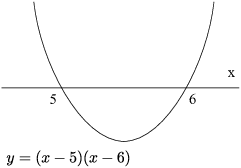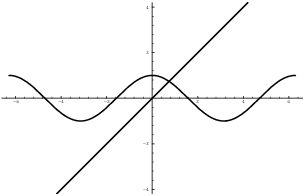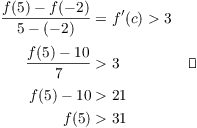An existence proof shows that an object exists. In some cases, this means displaying the object, or giving a method for finding it.
Example. Show that there is a real number x
such that ![]() but
but ![]() .
.
There are many possibilities; for example,
![]()
Example. Show that there is a real number x
such that ![]() .
.
Rewrite the inequality as
![]()
The graph of ![]() looks like this:
looks like this:

The graph lies below the x-axis between ![]() and
and ![]() . So, for example,
. So, for example, ![]() meets the conditions:
meets the conditions:
![]()
In some cases, you can know that an object exists without having any way of finding it (or finding it exactly). By analogy:
(a) If you throw your keys into a corn field, you know your keys are in the field --- but you may have trouble finding them!
(b) You know that Calvin Butterball has a birthday, even though you don't know what day it is.
You've seen results of this kind in calculus. One such result is:
Theorem. ( The Intermediate
Value Theorem:) Let f be a continuous function on the interval
![]() . Suppose that c is a number between
. Suppose that c is a number between ![]() and
and ![]() . Then
. Then ![]() for some x in the interval
for some x in the interval ![]() .
.
The Intermediate Value Theorem does not tell you how to find
an x such that ![]() --- it simply guarantees
that such an x exists.
--- it simply guarantees
that such an x exists.
Example. Show that there is a real number x
such that ![]() .
.
The assertion means that the graphs of ![]() and
and ![]() intersect:
intersect:

It looks like they do. Note, however, that a picture is not a proof.
Let ![]() . Then
. Then
![]()
Since ![]() is positive and
is positive and ![]() is negative, and since f is continuous for all x, the
Intermediate Value Theorem implies that there is an x between 0 and
is negative, and since f is continuous for all x, the
Intermediate Value Theorem implies that there is an x between 0 and
![]() for which
for which ![]() . Then
. Then ![]() , so
, so ![]() .
.
Notice that the Intermediate Value Theorem doesn't tell you what x
is, or how to find it. (It's approximately 0.73909.)![]()
Example. Suppose f is a continuous function satisfying
![]()
Prove that there is a number c such that ![]() and
and
![]()
The function ![]() is continuous.
is continuous.
![]()
Since 10 is between 26 and 4, there is a number c such that ![]() and
and
![]()
To say that there is an x satisfying a certain property does not mean that there is only one x satisfying the property. If that is what is meant, it has to be stated explicitly. Hence, there might be many values which satisfy the conclusion of the Intermediate Value Theorem.
Here's another existence theorem from calculus:
Theorem. ( Mean Value
Theorem) Suppose f is function which is continuous on the closed
interval ![]() and differentiable on the open
interval
and differentiable on the open
interval ![]() . Then there is a number c such that
. Then there is a number c such that ![]() and
and
![]()
Example. Find a number c which satisfies the
conclusion of the Mean Value Theorem when it is applied to ![]() on the interval
on the interval ![]() .
.
Note that
![]()
Now ![]() , so setting
, so setting ![]() , I find that
, I find that ![]() . Both of these values satisfy the conclusion of the
Mean Value Theorem.
. Both of these values satisfy the conclusion of the
Mean Value Theorem.![]()
Example. Suppose f is a differentiable function satisfying
![]()
Prove that ![]() .
.
Applying the Mean Value Theorem to f on the interval ![]() gives a number c such that
gives a number c such that ![]() and
and
![]()
Then

Rolle's theorem is special case of the Mean
Value Theorem: With the assumptions of the theorem, if ![]() , then there is a number c such that
, then there is a number c such that ![]() and
and
![]()
That is, c is a critical point of f.
Example. Let ![]() . Prove
that there is a number c between 1 and
. Prove
that there is a number c between 1 and ![]() such that
such that ![]() .
.
f is differentiable. Moreover,
![]()
By Rolle's theorem, there is a number c between 0 and ![]() such that
such that ![]() .
.![]()
In the last example, I found numbers satisfying the conclusion of the theorem --- but again, there is no guarantee that I can find such numbers explicitly. The theorem just says that at least one such number exists.
Copyright 2019 by Bruce Ikenaga